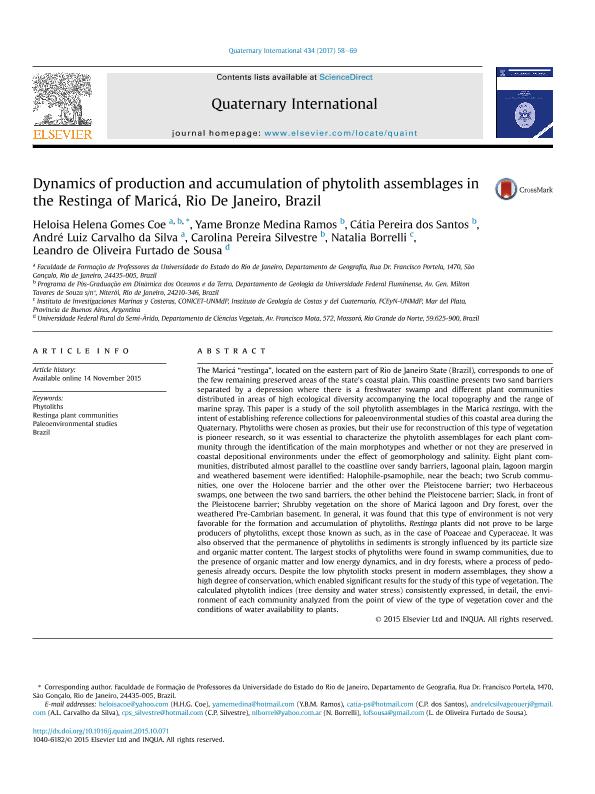Artículo
Dynamics of production and accumulation of phytolith assemblages in the Restinga of Maricá, Rio De Janeiro, Brazil
Gomes Coe, Heloisa Helena; Medina Ramos, Yame Bronze; Pereira dos Santos, Catia; Carvalho da Silva, André Luiz; Pereira Silvestre, Carolina; Borrelli, Natalia Lorena ; Furtado de Sousa, Leandro de Oliveira
; Furtado de Sousa, Leandro de Oliveira
 ; Furtado de Sousa, Leandro de Oliveira
; Furtado de Sousa, Leandro de Oliveira
Fecha de publicación:
14/04/2017
Editorial:
Pergamon-Elsevier Science Ltd
Revista:
Quaternary International
ISSN:
1040-6182
e-ISSN:
1873-4553
Idioma:
Inglés
Tipo de recurso:
Artículo publicado
Clasificación temática:
Resumen
The Maricá “restinga”, located on the eastern part of Rio de Janeiro State (Brazil), corresponds to one of the few remaining preserved areas of the state's coastal plain. This coastline presents two sand barriers separated by a depression where there is a freshwater swamp and different plant communities distributed in areas of high ecological diversity accompanying the local topography and the range of marine spray. This paper is a study of the soil phytolith assemblages in the Maricá restinga, with the intent of establishing reference collections for paleoenvironmental studies of this coastal area during the Quaternary. Phytoliths were chosen as proxies, but their use for reconstruction of this type of vegetation is pioneer research, so it was essential to characterize the phytolith assemblages for each plant community through the identification of the main morphotypes and whether or not they are preserved in coastal depositional environments under the effect of geomorphology and salinity. Eight plant communities, distributed almost parallel to the coastline over sandy barriers, lagoonal plain, lagoon margin and weathered basement were identified: Halophile-psamophile, near the beach; two Scrub communities, one over the Holocene barrier and the other over the Pleistocene barrier; two Herbaceous swamps, one between the two sand barriers, the other behind the Pleistocene barrier; Slack, in front of the Pleistocene barrier; Shrubby vegetation on the shore of Maricá lagoon and Dry forest, over the weathered Pre-Cambrian basement. In general, it was found that this type of environment is not very favorable for the formation and accumulation of phytoliths. Restinga plants did not prove to be large producers of phytoliths, except those known as such, as in the case of Poaceae and Cyperaceae. It was also observed that the permanence of phytoliths in sediments is strongly influenced by its particle size and organic matter content. The largest stocks of phytoliths were found in swamp communities, due to the presence of organic matter and low energy dynamics, and in dry forests, where a process of pedogenesis already occurs. Despite the low phytolith stocks present in modern assemblages, they show a high degree of conservation, which enabled significant results for the study of this type of vegetation. The calculated phytolith indices (tree density and water stress) consistently expressed, in detail, the environment of each community analyzed from the point of view of the type of vegetation cover and the conditions of water availability to plants.
Palabras clave:
Brazil
,
Paleoenvironmental Studies
,
Phytoliths
,
Restinga Plant Communities
Archivos asociados
Licencia
Identificadores
Colecciones
Articulos(IIMYC)
Articulos de INSTITUTO DE INVESTIGACIONES MARINAS Y COSTERAS
Articulos de INSTITUTO DE INVESTIGACIONES MARINAS Y COSTERAS
Citación
Gomes Coe, Heloisa Helena; Medina Ramos, Yame Bronze; Pereira dos Santos, Catia; Carvalho da Silva, André Luiz; Pereira Silvestre, Carolina; et al.; Dynamics of production and accumulation of phytolith assemblages in the Restinga of Maricá, Rio De Janeiro, Brazil; Pergamon-Elsevier Science Ltd; Quaternary International; 434; 14-4-2017; 58-69
Compartir
Altmétricas



